6 YELLOWTAILS
Introduction and species identification
The genus Seriola (family Carangidae, order Perciformes, class Actinopterygii) includes 47 species. In this report, three of these are considered: Seriola quinqueradiata, Seriola dumerili, and Seriola lalandi. In Japanese literature (e.g. Nakada 2000; Nakada and Murai 1991; Nakada, pers. comm.
2002), the English names of these fish are usually identified as yellowtail
(S. quinqueradiata), amberjack (S. dumerili) and goldstriped amberjack (S. lalandi). However, the term yellowtail is often used in a generic sense for Seriola spp. Therefore, to prevent confusion (and with great respect to the Japanese authors), wherever possible the “FAO” English names have been used where specific types of yellowtail are being referred to in the chapter, namely the Japanese amberjack (S. quinqueradiata), the greater amberjack (Seriola dumerili), and the yellowtail amberjack (S. lalandi). Several Japanese terms for yellowtail are also frequently used in this chapter. These include “mojako” (Japanese amberjack <50 g), “hamachi” (Japanese amberjack <5 kg), “buri” (Japanese amberjack >5 kg), “kampachi” (greater amberjack), and “hiramasa” (yellowtail amberjack).
The greater amberjack, S. dumerili, is a cosmopolitan species, found in warm waters all over the world. Its main morphological characteristics are the elongated, fusiform and slightly laterally compressed body, covered with small scales (cycloids). Their colour is yellow-green in juveniles; in adults it is blue or olivaceous dorsally and silvery to white on the sides and belly. S. dumerili is a multiple spawning fish, and it may release several batches of eggs during the same spawning season. The ovary type in this group is synchronous: at least two size groups of oocytes are present at the same time (Grau 1992). This species is gonochoric without sexual dimorphism, and both sexes are separated. According to Micale et al. (1993), maturity occurs at three years of age but functional breeders are 4 and 5 years old for males and females respectively. Marino et al. (1995) reported the first reproductive season for this species to be at 4 years of age for both sexes, even though 40% of males are sexually mature at 3 years of age.
Japanese amberjack (S. quinqueradiata) are present in the Western Central Pacific Ocean from Japan and the eastern Korean Peninsula to the Hawaiian Islands. This species reaches a maximum size of 150 cm TL (male/unsexed) and a maximum weight of 40 kg. It shows asynchronous oocyte development.
Yellowtail amberjack (Seriola lalandi) are present in Atlantic, Pacific and Western Indian Oceans. It is considered a circumglobal species, supporting commercial and recreational fisheries worldwide. This species is a spring-summer spawner, with a multiple group synchronous oocyte development and, like the greater amberjack (S. dumerili), has the capacity for multiple spawning within a reproductive season. The smallest size at which females caught in New Zealand matured was 775 mm FL; 50% reached sexual maturity at 944 mm, while all were mature at 1 275 mm (Poortenaar, Hooker and Sharp 2001); McGregor (1995) reported maturity at 580-670 mm. In Australia, according to Gillanders, Ferrel and Andrew (1999a,b), mature females of this species appeared at 698 mm (3 years) reaching 50% at 834 mm (4-5 years). The differences in size between these 2 populations could be attributed to different rearing conditions.
Tables 55-57 summarize the characteristics of these species, while Figures 102-107 illustrate their appearance and geographical location.
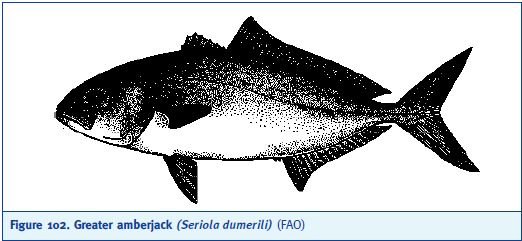
Seriola dumerili (Risso, 1810)
Figure 102. Greater amberjack (Seriola dumerili) (FAO)
Table 55. Characteristics of the greater amberjack (Seriola dumerili) (FishBase 2002, modified)
Common name Greater amberjack.
Size and age Maximum reported size 180-190 cm TL and maximum weight 80.6 kg, but commonly are 110 cm and 25-40 kg (Paxton et al. 1989; Smith-Vaniz 1986).
Environment Marine, reef-associated. 1-360 m depth.
Climate and latitude Lives in a subtropical climate at 45°N-28°S (Paxton et al. 1989) and is both epibenthic and epipelagic (Smith-Vaniz 1986).
Resilience Minimum population doubling time about 1.4-4.4 years, with medium resilience.
Distribution Circumglobal. Indo-West Pacific: South Africa, Persian Gulf, southern Japan and the Hawaiian Islands, south to New Caledonia, Mariana and Caroline Islands, in Micronesia; West Atlantic, Bermuda, from Mediterranean to the Gulf of Biscay and rarely off the British Coast; Nova Scotia (Canada) to Brazil, also from the Gulf of Mexico and the Caribbean Sea (Cervigon 1992).
Biology and ecology Marino et al. (1995) reported the first reproductive season for this species to be at 4 years of age for both sexes. The spawning season lasts from late spring to early summer (from May to July) (Lazzari and Barbera 1988, 1989a; Grau 1992) in the Mediterranean. Feeds primarily on fish but also invertebrates (Smith-Vaniz 1986). Small juveniles are associated with floating plants in oceanic and offshore waters and form small schools or may be solitary.
Importance This species is very important for fisheries and aquaculture (Frimodt 1995).

Figure 103. Zoological sites sampled for geographic distribution (indicated by the red squares) of Seriola dumerili (FishBase 2002)
Seriola quinqueradiata (Temminck and Schlegel, 1845)
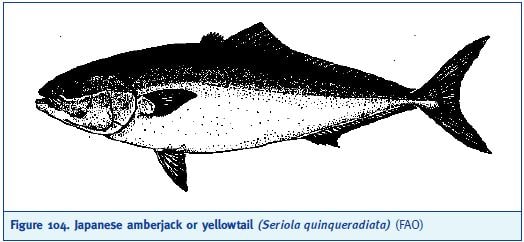
Figure 104. Japanese amberjack or yellowtail (Seriola quinqueradiata) (FAO)
Table 56. Characteristics of the Japanese amberjack or yellowtail (Seriola quinqueradiata) (FishBase 2002, modified)
Common name Japanese amberjack or yellowtail.
Size and age Maximum size of 150 cm TL (male/unsexed) and maximum weight 40 kg.
Environment Marine demersal species that lives at 100 m depth (Robins et al. 1991).
Climate and latitude Subtropical climate (32°N-20°N).
Resilience Minimum population doubling time is less than 15 months, with high resilience.
Distribution Present in the North West Pacific Ocean from Japan and the eastern Korean Peninsula.
Biology and ecology This species spawns about February-March. However, when held in captivity it begins maturing and spawning two months later in late April to early May (Mushiake 1997). The species exhibits shoaling habit (Frimodt 1995). Juveniles are found among floating seaweeds (Safran 1990).
Importance High commercial importance in fisheries and in aquaculture, in particular in Japan where the young are collected, raised in captivity and marketed fresh for “sashimi” (Frimodt 1995).
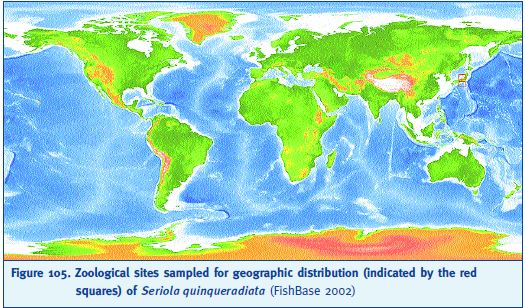
Figure 105. Zoological sites sampled for geographic distribution (indicated by the red squares) of Seriola quinqueradiata (FishBase 2002)
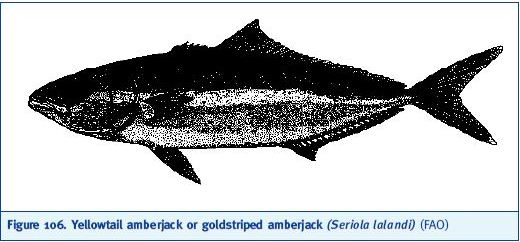
Seriola lalandi (Valenciennes, 1833)
Figure 106. Yellowtail amberjack or goldstriped amberjack (Seriola lalandi) (FAO)
Table 57. Characteristics of the yellowtail amberjack or goldstriped amberjack (Seriola lalandi) (FishBase 2002, modified)
Common name Yellowtail amberjack or goldstriped amberjack.
Size and age Maximum length 250 cm TL (male/unsexed) and maximum weight about 97 kg.
Environment Pelagic and demersal. Brackish and marine waters, 50 m depth, with a temperature range of 18-24°C (Paxton et al. 1989).
Climate and latitude Subtropical (54°N - 43°S).
Resilience The minimum population doubling time is less than 15 months with an high resilience.
Distribution Circumtropical, entering into temperate waters in some areas. Indo-Pacific: Japan, Great Australian Bight and Southeast Australia. Reported from Walters Shoal (Fricke 1999). In the Eastern Pacific it is found in British Columbia, Canada to Chile (Eschmeyer, Herald and Hammann 1983); Eastern Atlantic: St. Helena, South Africa (Smith-Vaniz, Quero and Desoutter 1990).
Biology and ecology Lives in coastal and oceanic waters and is both pelagic and demersal (Smith-Vaniz 1995), sometimes entering estuaries (May and Maxwell 1986). Can sometimes be found in cooler waters. Can be solitary or found in small groups near rocky shores, reefs and islands and off kelp beds (Eschmeyer, Herald and Hammann 1983). Juveniles are present in offshore waters as schools, very often near or beyond the continental shelf (Smith 1987). Feeds on small fish, squid and crustaceans (Bianchi et al. 1993).
Importance This species is important for fisheries and aquaculture and in the market is sold fresh and salted/dried (Smith-Vaniz 1995).
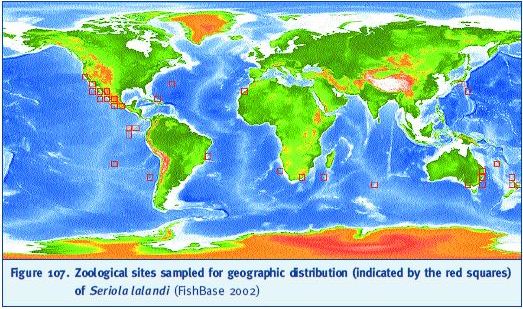
Figure 107. Zoological sites sampled for geographic distribution (indicated by the red squares) of Seriola lalandi (FishBase 2002)